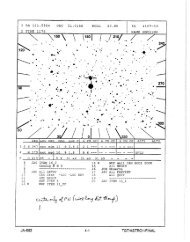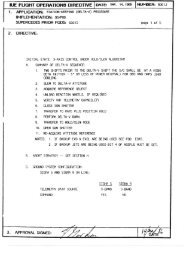The FUSE Archival Data Handbook - MAST - STScI
The FUSE Archival Data Handbook - MAST - STScI
The FUSE Archival Data Handbook - MAST - STScI
You also want an ePaper? Increase the reach of your titles
YUMPU automatically turns print PDFs into web optimized ePapers that Google loves.
4.2.1.3.1 Corrupted <strong>Data</strong><br />
Occasionally, photon arrival times in raw TTAG data files are corrupted. When this happens,<br />
some fraction of the photon events have identical, usually large TIME values, and the goodtime<br />
intervals (GTI) contain an entry with START and STOP set to the same large value.<br />
<strong>The</strong> longest valid exposure spans 55 ks. If an entry in the GTI table exceeds this value, the<br />
corresponding entry in the timeline table is flagged as bad using the “photon arrival time<br />
unknown” flag; (see Dixon et al. [2007]). Bad TIME values less than 55 ks will not be detected<br />
by the pipeline.<br />
Raw HIST files may also be corrupted. OPUS fills missing pixels in a HIST image with<br />
the value 21865. <strong>The</strong> pipeline sets the WEIGHT of such pixels to zero and flags them as bad.<br />
This is done by setting the photon’s “fill-data bit” (see Dixon et al. [2007]). Single bit-flips are<br />
corrected on-board, but occasionally a cosmic ray will flip two adjacent bits. Such double bitflips<br />
are not detected by the correction circuitry, producing (for high-order bits) a “hot pixel”<br />
in the image. <strong>The</strong> pipeline searches for pixels with values greater than 8 times the average of<br />
their neighbors, and masks out the higher-order bits.<br />
One or more image extensions may be missing from a raw HIST file. If no extensions<br />
are present, the keyword EXP STAT in the IDF header is set to −1. Exposures with nonzero<br />
values of EXP STAT are processed normally by the pipeline, but are not included in the<br />
observation-level spectral files ultimately delivered to <strong>MAST</strong>. Though the file contains no data,<br />
the header keyword EXPTIME is not set to zero.<br />
4.2.1.3.2 Airglow Observations<br />
When creating the IDF files for bright-earth observations (programs M106 and S100) or 900level<br />
airglow exposures, Cal<strong>FUSE</strong> sets the header keyword EXP STAT = 2. For 900-level<br />
exposures, the SRC TYPE is set to EE, and the following warning is written to the file header:<br />
“Airglow exposure. Not an astrophysical target.” <strong>The</strong> pipeline then processes the file as usual.<br />
In particular, the limb-angle flag is set in the timeline table (extension 3 of the IDF), and the<br />
“Time with low limb angle” is written to the file header. However, the following things change:<br />
• no jitter correction is performed;<br />
• when the time-dependent flags are copied from the timeline table to the individual photons,<br />
the limb-angle flag is masked out; and<br />
• when the good-time intervals and exposure time are calculated, the limb-angle flag is<br />
ignored.<br />
<strong>The</strong> extracted spectra include photons obtained at low limb angles. <strong>The</strong> detector-image<br />
plots (*spec.gif) do, too. But the count-rate plots (*ext.gif; *rat.gif) still indicate times<br />
when the line of sight passed below the nominal limb-angle limit.<br />
28




